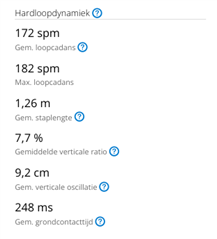Hi,
Only recently I am using the HRM pro plus with running dynamics.
What I noticed is that for calculating vertical ratio Garmin uses step length instead of stride length which results in wrong % vertical ratio. This because vertical ratio = vertical oscilation / stride length.
As commonly known step = distance between keft and right foot, stride = distance between the same foot (+/- x2 step length).
However, for Garmin step length and stride length is the same (see picture attached) and thus devides vertical oscilation / step length. Which returns a false vertical oscilation %.
Do you experience the same fault in your vertical ratie %?
E.g.
Step length recorded by HRM pro plus = 0,77 m
Vertical oscilation = 8,6 cm
Vertical ratio = 11% (8,6/0,77)
However stride length = 1,26 m (recorded with Wahoo Tick X)
Vertical ratio should be 7,3% (8,6/1,22)





